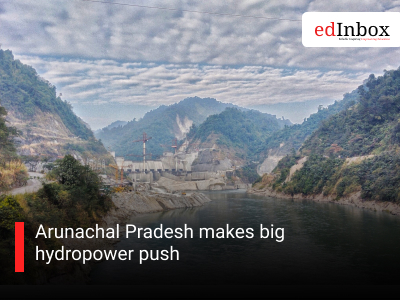The Oju Hydroelectric Power Project (HEP) is the latest among a host of major dams planned to enhance the state government's hydropower portfolio. A 2,200 MW hydropower project was approved to be set up in the Upper Subansiri district of Arunachal Pradesh, marking the state government's intention to quickly increase hydropower production within the state.
The Oju HEP was greenlit by the centrally-appointed Expert Appraisal Committee (EAC) on September 12, subject to the Navayuga Engineering group — the developer of the project — incorporating simulations of glacial lake outburst flood scenarios into its project. The Committee recommended that a real-time monitoring and early warning system (EWS) will be set up in coordination with State Disaster Management Authority (SDMA) and local administration, besides community awareness and mock drills for preparedness," the EAC stated, in view of increased glacial lakes in the area.
The Oju HEP is the second large dam to receive clearance in the Subansiri river basin. The 2000 MW run-of-river project (tapping the natural flow of a river) further downstream, the Subansiri Lower Dam, was cleared in 2003, but was under severe opposition from local people and activists regarding the adverse effects between 2010 and 2019. "When Subansiri Lower Dam was being cleared, one of the conditions was that there would be no construction further upstream." stated Himanshu Thakkar, coordinator of South Asia Network on Dams, Rivers and People. This was appealed and now projects like Oju have been permitted on a case-to-case basis."
The complete, cumulative effect of several dams on the river system is also not known. The Subansiri basin lies in Seismic Zone V, the most high-risk category, and the data that was used for the carrying capacity of the river was published the last time in 2014 — more than ten years ago. The Oju HEP environment impact assessment states that no protected areas or biodiversity reserves exist where the power project site is located.
'Decade of hydropower'
Approval for the Oju HEP follows a large effort by the state government to produce additional hydroelectricity and "secure" border regions near China.It is a ten-year mission to expedite all green energy schemes," said chief minister Pema Khandu at an August press conference. "Green energy will be our strength, export, and identity."
"The pace at which the projects are being cleared in Arunachal Pradesh becomes a matter of concern regarding the impact assessment quality.". We’ve seen with the Subansiri Lower Project that mistakes about downstream impacts were made, that needed to be corrected,” said Sumit Vij, assistant professor at Wageningen University in the Netherlands. A rigorous review of the Lower Subansiri Dam's EIA concluded that it had only conducted downstream surveys up to seven kilometres downstream from the dam location and did not register key endangered species such as the Ganges river dolphin, which is frequently occurring in the river.
Similar arguments have been made by indigenous groups engaged in clearance activities for dams proposed throughout the state. For the 2,880 MW Dibang Multipurpose Project, situated in the state's eastern boundary, communities protested against losing their ancestral lands used as mithun grazing areas and for cultivation of medicinal plants.
Over 200 individuals participated in the public hearing for the Oju HEP. Minutes of the meeting included as an annexure to the impact assessment report identify apprehensions of families that were present. For instance, Keru Chader, a person belonging to the Nah tribe, expressed apprehension regarding losing grazing lands and compared it to "a holy place like Amarnath." In reply, the administration merely stated, "no impact on holy places in the project area and its surroundings are envisaged."
Water and Power Consultancy Services India Ltd (WAPCOS), an engineering consultancy and central public sector enterprise, conducted the environmental impact studies of the Lower Subansiri Infrastructure Project and the Oju HEP. It also prepared the impact study of the 1,200 MW Kalai II Hydropower project that is to be constructed on the Lohit river. A legal notice dated September 9, seen by Mongabay India, accuses the impact study for the Kalai II project of having been "prepared without undertaking any fresh scientific studies, site-specific assessments, or updates to present current environmental, social, and ecological conditions." WAPCOS is accredited by the National Accreditation Board for Education and Training to conduct environmental impact studies.
The central government is taking an active part in funding Arunachal Pradesh's hydropower dreams. In 2023, the central government signed a Memorandum of Understanding with the state to acquire 12 dams whose development had been in limbo — among them the 3,097 MW Etalin project. Central Public Sector Undertakings, and not private operators, would acquire operations to make them more efficient, the government said
Arunachal Pradesh makes big hydropower push
Typography
- Smaller Small Medium Big Bigger
- Default Helvetica Segoe Georgia Times
- Reading Mode





